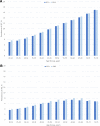Global Prevalence of Prediabetes
- PMID: 37196350
- PMCID: PMC10442190
- DOI: 10.2337/dc22-2376
Global Prevalence of Prediabetes
Abstract
Objective: To estimate the global, regional, and national prevalence of prediabetes, defined by impaired glucose tolerance (IGT) or impaired fasting glucose (IFG).
Research design and methods: We reviewed 7,014 publications for high-quality estimates of IGT (2-h glucose, 7.8-11.0 mmol/L [140-199 mg/dL]) and IFG (fasting glucose, 6.1-6.9 mmol/L [110-125 mg/dL]) prevalence for each country. We used logistic regression to generate prevalence estimates for IGT and IFG among adults aged 20-79 years in 2021 and projections for 2045. For countries without in-country data, we extrapolated estimates from countries with available data with similar geography, income, ethnicity, and language. Estimates were standardized to the age distribution for each country from the United Nations.
Results: Approximately two-thirds of countries did not have high-quality IGT or IFG data. There were 50 high-quality studies for IGT from 43 countries and 43 high-quality studies for IFG from 40 countries. Eleven countries had data for both IGT and IFG. The global prevalence of IGT in 2021 was 9.1% (464 million) and is projected to increase to 10.0% (638 million) in 2045. The global prevalence of IFG in 2021 was 5.8% (298 million) and is projected to increase to 6.5% (414 million) in 2045. The 2021 prevalence of IGT and IFG was highest in high-income countries. In 2045, the largest relative growth in cases of IGT and IFG would be in low-income countries.
Conclusions: The global burden of prediabetes is substantial and growing. Enhancing prediabetes surveillance is necessary to effectively implement diabetes prevention policies and interventions.
© 2023 by the American Diabetes Association.
Conflict of interest statement
Figures



Comment in
-
Comment on Rooney et al. Global Prevalence of Prediabetes. Diabetes Care 2023;46:1388-1394.Diabetes Care. 2023 Dec 1;46(12):e220. doi: 10.2337/dc23-1606. Diabetes Care. 2023. PMID: 38011524 No abstract available.
-
Comment on Rooney et al. Global Prevalence of Prediabetes. Diabetes Care 2023;46:1388-1394.Diabetes Care. 2023 Dec 1;46(12):e221. doi: 10.2337/dc23-1580. Diabetes Care. 2023. PMID: 38011526 No abstract available.
-
Comment on Rooney et al. Global Prevalence of Prediabetes. Diabetes Care 2023;46:1388-1394.Diabetes Care. 2023 Dec 1;46(12):e219. doi: 10.2337/dc23-1539. Diabetes Care. 2023. PMID: 38011527 Free PMC article. No abstract available.
References
-
- Abdul-Ghani MA, Tripathy D, DeFronzo RA. Contributions of β-cell dysfunction and insulin resistance to the pathogenesis of impaired glucose tolerance and impaired fasting glucose. Diabetes Care 2006;29:1130–1139 - PubMed
-
- Nathan DM, Davidson MB, DeFronzo RA, et al. Impaired fasting glucose and impaired glucose tolerance: implications for care. Diabetes Care 2007;30:753–759 - PubMed
Publication types
MeSH terms
Substances
Associated data
Grants and funding
LinkOut - more resources
Full Text Sources
Medical

